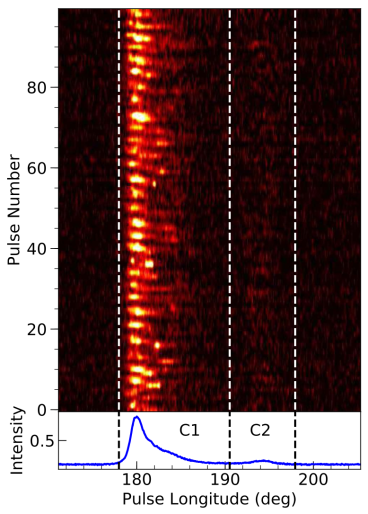The Five-hundred-meter Aperture Spherical Radio Telescope (FAST) is the largest telescope ever built by far, which has discovered more than 200 pulsars. PSR J1631+1252 is an isolated normal pulsar with a rotational period of 0.310s discovered by the FAST in the Commensal Radio Astronomy FAST Survey (CRAFTS).
Using the follow-up timing observations over a year, WEN Zhigang, an astronomer from the pulsar group at the Xinjiang Astronomical Observatory (XAO) of the Chinese Academy of Sciences (CAS), and his co-researchers have performed a detailed study on the pulse-to-pulse energy distribution and longitude-resolved modulation properties of PSR J1631+1252 at 1250 MHz.
The dispersion measure (DM) of the pulsar is determined to be 32.73 pc cm-3. The DM-based distance is derived to be around 2.0 kpc from the NE2001 model for the Galactic free-electron distribution. The first period derivative is measured to be 4.03×10-17 s s-1, implying a characteristic age of around 122 Myr.
The representative surface-dipole magnetic field strength is 1.13×1011 G. The spin-down energy loss is 5.34×1031 erg s-1. The pulse-to-pulse energy distribution can be well described by a lognormal distribution with approximately constant fitting parameters. The lognormal statistics can be interpreted in terms of a pure stochastic growth theory, and the associated pulsar emission mechanism is suggested involving only linear processes.
Using the fluctuation spectral analysis, PSR J1631+1252 is identified as a subpulse drifter. The leading component is phase-modulated with a drifting periodicity of 3.28 rotational periods. A bimodal distribution is present in the time interval between successive drift bands, which implies that the pulsar possibly consists of two different drift patterns. The physical mechanism associated with subpulse drifting is explained in the context of the rotating carousel model.
The results of this research provide more insights into the physics of pulsar emission mechanism and the physical state of pulsar magnetospheres. The study was published on April 10, 2022 in ApJ.

Figure 1: Sample of a single-pulse sequence is displayed as a function of pulse longitude and number for PSR J1631+1252. Significant subpulse drifting is apparent in the leading component. The average pulse profile is shown in the lower panel with intensity normalized to unity. The leading and trailing emission components are distinguished with vertical dashed lines.
Contact: Zhigang Wen
Xinjiang Astronomical Observatory, Chinese Academy of Sciences
Email: wenzhigang@xao.ac.cn
Article link: https://iopscience.iop.org/article/10.3847/1538-4357/ac5d5d